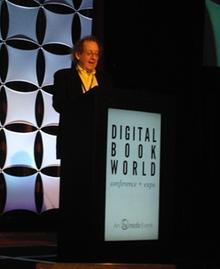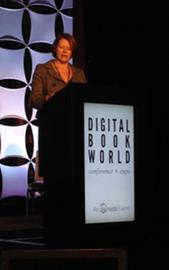Publishers, industry analysts, consultants and start-ups convened at the Sheraton Hotel in New York, N.Y., yesterday for the first day of Digital Book World 2014 to discuss the business challenges posed by an ever-changing digital landscape, where, among other trends, e-book sales are leveling off and a hybrid approach to reading print and digital titles is taking hold among readers.

|
|
| Mike Shatzkin | |
Mike Shatzkin, the CEO of the Idea Logical company, ruminated during his opening remarks on the differences between the state of the industry today and the state of the industry in 2010, when the first Digital Book World conference was held. Today, he said, publishers have to contend with a single dominant retailer in Amazon; one nationwide bricks-and-mortar retailer in Barnes & Noble; a single publishing house as big as the next four largest combined; and the proliferation of digital, direct-to-consumer self-publishing.
In an aside that drew scattered laughter, Shatzkin noted that "thanks to the Department of Justice," Amazon has managed to fend off the other e-reading devices that had begun to challenge the Kindle's market dominance. And although e-book sales growth is declining and the rate of change is slower, Shatzkin insisted that the disruption is not over: Amazon's share of book sales continues to grow, sales will continue to move online, the temptation for authors to forgo publishers entirely is increasing, and physical, retail shelf space is dwindling.
During a subsequent CEO roundtable, Carolyn Reidy, president and CEO of Simon & Schuster, pointed to the loss of physical retail space (due to the demise of Borders, struggles of Barnes & Noble and big-box retailers potentially moving away from carrying books) and the difficulties of digital discoverability as the biggest problems that traditional publishers are trying to solve.
"Although we're competing with all other media, that's always been a challenge," said Reidy. "The biggest thing is the need to strengthen where books are; the great danger is that some outlets might decide to not carry books anymore.
Despite these concerns, Simon & Schuster posted a record quarter, as noted by moderator Michael Cader of Publishers Lunch. The greatest area for growth for publishers, Reidy responded, was in international digital sales.
"We sold an e-book in over 200 countries last year. And we sold a copy of The Sun Also Rises in Antarctica," Reidy said, adding that increasing global penetration of e-books hasn't affected international print sales.
 |
|
| Jo Henry | |
Jonathan Nowell and Jo Henry, president and director of Nielsen Book, respectively, presented data on international e-book markets. Henry described the U.S. e-book market as mature, diverse, dominated by fiction and much less committed. Within the last year, Henry noted, more people have been buying e-books than reading e-books--the implication being that people are buying e-books simply because they've got the device. Most encouragingly for bricks-and-mortar stores, the data showed evidence of a "hybrid" market: more than half of all books bought by e-reader owners were print books. And discounting gift purchases and print books for children, e-reader owners still bought a "significant portion" of their books in print.
Henry ended her presentation on the U.S. book market by highlighting trends in teen reading. She reported a "shocking" rise in the percentage of teens who don't read for pleasure; as of fall 2013, 41% of teens said that they don't read for pleasure.
"This has implications for all of us as they become adult consumers," warned Henry. --Alex Mutter

